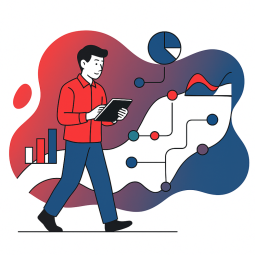Do you hear AI jargon and you're not sure if you need to know what it means or if it’s relevant to your not-for-profit? We’ve put together a focused list of key AI terminology that you are likely to hear and what it means for NFPs. This list is designed to help you feel more confident when conversations stray into technical terminology, and some questions you should ask if you hear the terms. This is by no means a complete list of terms but hopefully will be able to help with some of the more frequently used terminology.
Artificial Intelligence (AI)
The simulation of human intelligence processes by machines, especially computer systems. These processes include learning, reasoning, and self-correction.
AI has been around for a long time but has recently surged into the general conversation through the widespread availability and use of tools like ChatGPT. As at the beginning of 2025, AI is likely to be in most of your commonly used computer programs, so you are already using it. The questions NFPs should be asking are, should we be considering adding more productivity-generating AI to our toolkit – like a ChatGPT subscription, or even experimenting with custom-built solutions like a chatbot? Questions about costs (what benefits will I get? Will they justify the costs and how do they compare with the benefits/costs of human input?) and ethics (communicating with stakeholders, keeping your data safe, addressing bias) come into play here.
Agentic AI
Agentic AI refers to artificial intelligence systems designed to act autonomously, making decisions and taking actions without human intervention. These systems are capable of perceiving their environment, analyzing data, and responding to inputs in a way that mimics human agency. Agentic AI can be found in applications such as self-driving cars, autonomous drones, and advanced robotics, where they perform tasks independently and adapt to changing circumstances. Agentic AI has also been explored in programs such as Google’s Gemini and Microsoft365’s Copilot, with the ability to send emails, organise meetings and conduct research on behalf of users.
Algorithmic Bias
Systematic and repeatable errors in a computer system that create unfair outcomes, such as privileging one arbitrary group over others. Addressing algorithmic bias is crucial for fair and ethical AI applications. We will talk about some ways to best do this shortly.
Algorithm
A set of rules or processes to be followed in calculations or other problem-solving operations, especially by a computer. Like a recipe, but for computers.
If you don’t know much about algorithms but want to learn more, you’re moving into the worlds of computer and data science, and the Internet is your friend. Otherwise, algorithms are a level of detail that is too much for most people working in NFPs but not in IT.
AI Ethics
The stage of AI integration into society in 2025 means that we are preoccupied with considering the moral and ethical implications of AI technologies, including issues such as bias, transparency, accountability, and the impact on employment and society. This is a critical stage and NFPs are uniquely placed to engage and understand the ethical implications of automation that AI involves.
One of the great contributions that NFPs can make is calling out bias when they see it and helping technicians by contributing ‘domain expertise’ to solving the problem. For example, if a data scientist has analysed a dataset, domain experts can help by asking questions about the data/results, pointing out anomalies, or discussing the ‘real-world’ context for the results. Check out the AI CARE framework to help your NFP make the right decisions about AI.
Bias
In machine learning, bias is the error from using a simplified model to represent a complex real-world issue.
Bias can also refer to everyday examples such as when an algorithm is trained with data from one type and lacks a range of types – data types could include race or gender, leading ML models to produce results that favour particular groups. Bias can be hard to avoid so understanding bias and how to deal with it is useful. Read more here.
Big Data
Extremely large datasets that can be analysed computationally to reveal patterns, trends, and associations. Big Data is often characterized by the three Vs: volume, velocity, and variety.
Some examples include social media data, emails, sensor data (eg. cameras monitoring how many people walk into a shopping centre) or bank transactions. This data can’t be analysed by traditional software or systems and needs tools like machine learning to generate insights from it.
Big data can help solve significant social problems, like helping identify unmet needs in cities, or uncovering gendered media reporting.
Chatbot
A software application used to conduct an online chat conversation via text or text-to-speech. Chatbots are used in customer service, information acquisition, and other interactive applications.
Some NFPs are experimenting with support worker and mental health support chatbots to supplement face-to-face services.
Data Preprocessing
Data is the foundation of all AI! Preprocessing data refers to the process of cleaning and transforming raw data into a format that can be used by machine learning algorithms. This may include handling missing values, normalising data, and encoding categorical variables.
If your NFP is considering building AI tools, then the data you will use is a fundamental issue for you. You should get skilled support from a data scientist or business analyst for this work. This is where the old adage ‘Garbage In, Garbage Out’ is deeply meaningful because if your data is incomplete, messy, or not set up for the task, your results will be garbage!
If you are working on or considering an AI project, ask questions about the data source, like how big and clean it is and what permissions/consent were obtained if the dataset uses individual-level data.
Deep Learning & Neural Networks
Deep Learning: A subset of machine learning that uses neural networks with many layers (hence "deep") to analyse various factors of data. It's particularly effective for tasks such as image and speech recognition.
Deep learning is part of chatbots and spam filters so it's part of our everyday AI use. Your NFP should understand it because it can generate problems with bias, privacy, fairness, and transparency. Knowing that deep learning is part of any AI that your organisation is using helps NFPs to manage these critical ethical issues. Learn more here.
Neural networks: A series of algorithms that attempt to recognise underlying relationships in a set of data through a process that mimics the way the human brain operates.
While you may not really need to know much about neural networks, it can be valuable to know if they were used to train the AI you use or develop. Like deep learning, neural networks are often the key methods behind why AI is so useful. But it also suffers the same challenges of learning patterns from data that go on to generate biased responses. For example, if all the datasets are from Western sources, then neural networks produce results that are culturally biased.
Hallucinations
In the context of AI, Hallucinations are answers to prompts that are factually incorrect. These hallucinations can occur if the data that the AI has been trained on inaccurate or biased information, not defining the purpose of the AI, or not defining the boundaries for AI models. To best prevent hallucinations, you can provide clear guidelines when prompting, use high-quality data that is diverse and free of bias, test your AI model consistently, and make sure that there is a human reviewer able to legitimise any responses provided.
Internet of Things (IoT)
A network of physical objects embedded with sensors, software, and other technologies to connect and exchange data with other devices and systems over the internet.
Climate focused NFPs may use IoT to monitor things like air quality, endangered species or rubbish collection. Cameras in public places to monitor crowds or support public safety are another example of IoT for public good.
Large Language Model (LLM)
Large Language Models are AI models that are designed to understand and generate text and other forms of content like a human. They can summarise text, infer information from context and generate contextually relevant responses. This is done using neural networks which are trained on vast amounts of data sets to help the LLM to predict the probability of the next work in a sentence based on the context provided by proceeding words. Programs like ChatGPT, Gemini, CoPilot and other chatbots are considered LLMs.
Machine Learning (ML)
A subset of AI that involves the use of algorithms and statistical models to enable a system to improve its performance on a specific task based on data, without being explicitly programmed.
NFPs can use ML for tasks such as analysing free-text data, like case notes. Many of the platforms used by NFPs already incorporate ML – think of how Microsoft Word suggests alternative words or phrases, based on your writing style, or the personalised results from your Google search. Some NFP examples are found here.
If you want to check a machine learning model, ask about things like the accuracy of the model. For example, it might be accurate 90% of the time and you are concerned about the 10% when the model is wrong. Check with the ML engineer, but also consider this against your existing human accuracy rate. People also make mistakes!
Natural Language Processing (NLP)
A field of AI focused on the interaction between computers and humans through natural language. It involves designing algorithms to understand and generate human language.
Some of the AI add-ins that are now available for programs allow users without specific technical skills to do more technical tasks. For example, you could analyse your spreadsheets using NLP by asking the question you want answered (e.g. how many clients are in an age bracket) rather than programming a particular function. This can be amazing, but beware – to quote a superhero’s uncle ‘with great power comes great responsibility’! You need to understand how to frame the right question and how to interpret the results.
Prompt Writing
Prompt writing refers to the practice of crafting specific inputs that guide an artificial intelligence model to generate desired responses. This can be in the form of questions, statements, or commands that provide clear and concise instructions. This helps the AI understand the context and deliver accurate, relevant, and coherent outputs. The more detail that is provided in the prompt, the more detailed and relevant of an answer you will receive.
Robotics
A branch of technology that deals with the design, construction, operation, and application of robots. Robotics often overlaps with AI to create intelligent machines, using large amounts of data and requiring complex analytics to program the robots for their specific tasks.
Robots are being used in healthcare settings to help staff with mundane tasks and even as support aids for dementia patients or the elderly.
The above should help you with understanding the sometimes-confusing world of AI. If there are any terms that you think might be worth including in this glossary, let us know! We'll be updating this page with more terms, so make sure to check back or bookmark this page for an easy reference point.





Status message
Thanks for rating this guide.